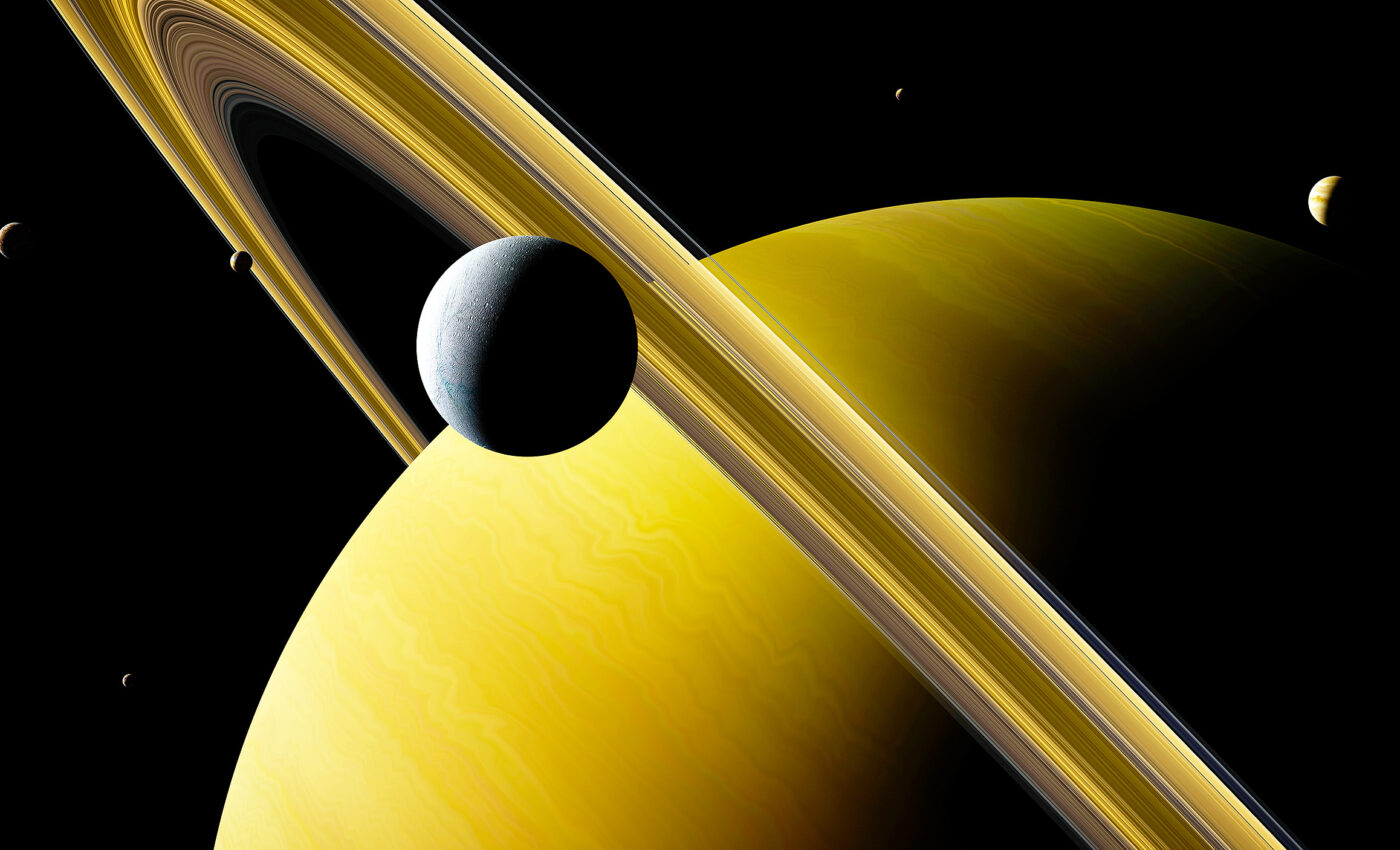
Saturn's "Death Star" moon, Mimas, has a very young global ocean
Researchers have discovered that Mimas, one of Saturn’s tiny moons, conceals a global ocean beneath its extensively cratered surface.
The research, led by Dr. Valéry Lainey of the Observatoire de Paris-PSL, has revealed the astonishing existence of a “young” ocean, estimated to have formed a mere 5 to 15 million years ago.
This revelation not only propels Mimas to the forefront of celestial bodies of interest within our solar system but also highlights its potential as a key subject in the ongoing quest to unravel the mysteries of life’s origins beyond Earth.
An ocean on Saturn’s moon Mimas
“Moons potentially harboring a global ocean are tending to become relatively common objects in the Solar System. The presence of these long-lived global oceans is generally betrayed by surface modification owing to internal dynamics,” wrote the study authors.
“Hence, Mimas would be the most unlikely place to look for the presence of a global ocean. Here, from detailed analysis of Mimas’s orbital motion based on Cassini data, with a particular focus on Mimas’s periapsis drift, we show that its heavily cratered icy shell hides a global ocean, at a depth of 20–30 kilometers.”
“Mimas is a small moon, only about 400 kilometers in diameter, and its heavily cratered surface gave no hint of the hidden ocean beneath,” said study co-author Dr. Nick Cooper, a research fellow at Queen Mary University of London.
“This discovery adds Mimas to an exclusive club of moons with internal oceans, including Enceladus and Europa, but with a unique difference: its ocean is remarkably young, estimated to be only 5 to 15 million years old.”
Unprecedented glimpse into ocean development
The estimation of the ocean’s age was made possible through meticulous analysis of Mimas’s tidal interactions with Saturn, which highlighted an unexpected irregularity in the moon’s orbit.
This anomaly was a critical clue, suggesting the ocean’s recent formation and providing an unprecedented glimpse into the nascent stages of ocean development and its implications for the emergence of life.
“The existence of a recently formed liquid water ocean makes Mimas a prime candidate for study, for researchers investigating the origin of life,” explained Dr. Cooper.
NASA’s Cassini spacecraft
The discovery was facilitated by data from NASA’s Cassini spacecraft, which dedicated over a decade to the exploration of Saturn and its moons.
By analyzing subtle shifts in Mimas’s orbit, scientists were able to deduce the presence of this concealed ocean, along with its dimensions and depth.
“This has been a great team effort, with colleagues from five different institutions and three different countries coming together under the leadership of Dr. Valéry Lainey to unlock another fascinating and unexpected feature of the Saturn system, using data from the Cassini mission,” said Dr. Cooper.
The unearthing of Mimas’s youthful ocean not only enriches our comprehension of the celestial mechanics and the potential habitability of moons orbiting the giant planets but also opens new pathways for future space exploration.
More about Saturn’s moon Mimas
As discussed above, Saturn’s moon Mimas, often referred to as the “Death Star” moon due to its striking resemblance to the iconic “Star Wars” space station, stands out as one of the most fascinating celestial bodies in our solar system.
Discovered in 1789 by William Herschel, Mimas orbits Saturn at a distance of about 185,520 kilometers (115,280 miles), making it one of the innermost of Saturn’s major moons.
Discovery and orbit
Spanning 396 kilometers (246 miles) in diameter, Mimas is the smallest of Saturn’s major moons. Despite its modest size, it plays a significant role in shaping the planet’s rings through orbital resonances.
These gravitational interactions create gaps and waves in Saturn’s rings, showcasing the moon’s influence beyond its immediate vicinity.
Striking features and ocean of Mimas
One of the most distinctive features of Mimas is the enormous crater named Herschel, after its discoverer. The crater measures about 130 kilometers (81 miles) across, occupying a significant portion of the moon’s surface.
The impact that created Herschel was so powerful that it nearly shattered Mimas. The crater’s walls are about 5 kilometers (3 miles) high, with a central peak rising 6 kilometers (about 4 miles) above the crater floor, highlighting the moon’s dramatic history.
Composition and structure
Mimas’s surface is heavily cratered and bears numerous marks of past collisions. The moon’s composition is primarily water ice, with low-density material that suggests a relatively homogeneous internal structure.
This composition is typical of the outer solar system’s icy bodies, contributing to our understanding of celestial body formation and evolution.
The moon’s orbit around Saturn takes about 22.6 hours, closely matching the rotation period of Saturn itself. This synchronous orbit means that Mimas always shows the same face to Saturn, a common trait among many moons in the solar system.
Scientific significance
Mimas’s intriguing features and its role in Saturn’s ring dynamics make it a subject of interest for astronomers and space missions alike.
Past missions like Voyager and Cassini have provided invaluable data about Mimas, enhancing our knowledge of its surface, composition, and the complex interactions within Saturn’s system.
In summary, Mimas is a testament to the natural beauty and diversity of our solar system’s celestial bodies, and also a key to understanding the dynamic processes that govern planetary rings and moon systems.
Its iconic appearance and scientific significance continue to inspire curiosity and exploration, making it a fascinating subject for further study and observation.
The study is published in the journal Nature.
—–
Like what you read? Subscribe to our newsletter for engaging articles, exclusive content, and the latest updates.
—–
Check us out on EarthSnap, a free app brought to you by Eric Ralls and Earth.com.
—–













